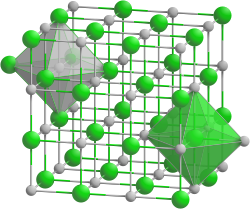Titanium carbide
| Crystal structure | |||||||||||||||||||
|---|---|---|---|---|---|---|---|---|---|---|---|---|---|---|---|---|---|---|---|

|
|||||||||||||||||||
| __ Ti 4+ __ C 4− | |||||||||||||||||||
| Crystal system |
cubic |
||||||||||||||||||
| Space group |
Fm 3 m (No. 225) |
||||||||||||||||||
| Coordination numbers |
Ti [6], C [6] |
||||||||||||||||||
| General | |||||||||||||||||||
| Surname | Titanium carbide | ||||||||||||||||||
| Ratio formula | TiC | ||||||||||||||||||
| Brief description |
gray to black, shiny silver connection |
||||||||||||||||||
| External identifiers / databases | |||||||||||||||||||
|
|||||||||||||||||||
| properties | |||||||||||||||||||
| Molar mass | 59.88 g mol −1 | ||||||||||||||||||
| Physical state |
firmly |
||||||||||||||||||
| density |
4.93 g cm −3 |
||||||||||||||||||
| Melting point |
3140 ° C |
||||||||||||||||||
| boiling point |
4820 ° C |
||||||||||||||||||
| solubility |
<10 mg l −1 in water |
||||||||||||||||||
| safety instructions | |||||||||||||||||||
|
|||||||||||||||||||
| MAK |
Switzerland: 5 mg m −3 (measured as inhalable dust ) |
||||||||||||||||||
| As far as possible and customary, SI units are used. Unless otherwise noted, the data given apply to standard conditions . | |||||||||||||||||||
Titanium carbide is an inorganic chemical compound made up of the elements titanium and carbon . Titanium carbide is very rarely found in nature as the mineral khamrabaevite .
Extraction and presentation
Titanium carbide is produced from titanium and methane during physical vapor deposition (PVD) :
In chemical vapor deposition (CVD) , titanium (IV) chloride is used as the starting material:
Titanium carbide can be produced by the carbothermal reduction of titanium dioxide
or by synthesis from the elements or by a growth process similar to titanium nitride . In the first reaction, mixed crystals in the form of titanium carbonitride (TiCN) or titanium carboxynitride (TiCON) can also arise, depending on the reaction conditions in air.
With a fixed titanium (IV) chloride / carbon tetrachloride ratio, particularly pure, stoichiometric titanium carbide is deposited on graphite rods heated to more than 1250 ° C.
properties
Titanium carbide is a gray, flammable powder that is practically insoluble in water. It is insoluble in hydrochloric acid and sulfuric acid, but soluble in nitric acid . In air it is stable up to 800 ° C. With very good electrical conductivity, it has a positive temperature coefficient. Titanium carbide has a crystal structure of the sodium chloride type with a considerable phase width (TiC 1.0 to TiC 0.3 ). In the substoichiometric compounds, the non-metal atoms remain vacant. Strikingly, full occupancy is not quite achieved (TiC 0.98 ). It is characterized by a particularly high hardness of up to 4000 HV. The bending strength is 240–400 MPa, the hardness HV1 is 22–30 GPa and the modulus of elasticity is 550–570 GPa.
use
The substance is used as a coating material for indexable inserts , milling tools , broaches , forming tools, saw blades, etc.
Titanium carbide is also used in general toolmaking and in the chemical industry as an essential component of the ferro-titanite family of sintered materials or generally as a component of rust and acid-resistant steels and hard metals . With up to 4% of the hard metals in group K, up to 10% in hard metals in group M and up to 43% in group P. Titanium carbide increases the heat resistance, hardness and oxidation resistance.
Individual evidence
- ^ Brockhaus ABC Chemie , VEB FA Brockhaus Verlag Leipzig 1965, p. 1421.
- ↑ a b c d e f Entry for CAS no. 12070-08-5 in the GESTIS substance database of the IFA , accessed on December 14, 2012 (JavaScript required)
- ↑ Schweizerische Unfallversicherungsanstalt (Suva): Limits - Current MAK and BAT values (search for 12070-08-5 or titanium carbide ), accessed on November 2, 2015.
- ↑ Mineral Atlas: Khamrabaevit
- ↑ Khamrabaevite . In: John W. Anthony, Richard A. Bideaux, Kenneth W. Bladh, Monte C. Nichols (Eds.): Handbook of Mineralogy, Mineralogical Society of America . 2001 ( handbookofmineralogy.org [PDF; 43 kB ; accessed on February 24, 2018]).
- ↑ a b c Georg Brauer (ed.), With the collaboration of Marianne Baudler a . a .: Handbook of Preparative Inorganic Chemistry. 3rd, revised edition. Volume II, Ferdinand Enke, Stuttgart 1978, ISBN 3-432-87813-3 , p. 1385.
- ↑ a b Horst Briehl: Chemistry of materials . Springer, 2007, ISBN 978-3-8351-0223-1 , pp. 244 ( limited preview in Google Book search).
- ↑ Erwin Riedel, Christoph Janiak: Inorganic Chemistry . Walter de Gruyter, 2011, ISBN 3-11-022567-0 , p. 788 ( limited preview in Google Book search).
- ↑ Werner Schatt, Klaus-Peter Wieters, Bernd Kieback: Powder Metallurgy . Springer, 2006, ISBN 978-3-540-23652-8 , pp. 506 ( limited preview in Google Book search).
- ↑ Eifeler Group: High Tech Coatings - Titanium Carbide
- ↑ Hans Kurt Tönshoff: Tools for modern production: Possibilities for rationalization in metal-cutting production (= contact & study . Volume 370 ). expert verlag, 1993, ISBN 3-8169-0766-0 , p. 50 ( limited preview in Google Book search).
- ↑ F. Frehn: New corrosion and wear-resistant, machinable hard materials: Ferro-Titanit for chemical technology . In: Materials and Corrosion . tape 30 , no. December 12 , 1979, pp. 870–872 , doi : 10.1002 / maco.19790301208 .
- ^ Deutsche Edelstahlwerke : Ferro-Titanit - powder-metallurgical hard materials
- ^ Hans-Jürgen Bargel, Günter Schulze: Material science . Springer DE, 2008, ISBN 978-3-540-79297-0 , pp. 333 ( limited preview in Google Book search).




